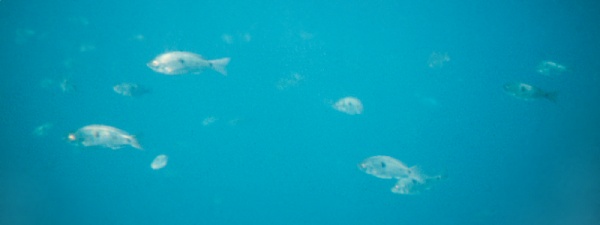What Is an "Utaka"?
 Part of a shoal of Utaka (Copadichromis sp.) near Monkey Bay, Malawi. Photo © by M. K. Oliver |

What Is an "Utaka"?
 Part of a shoal of Utaka (Copadichromis sp.) near Monkey Bay, Malawi. Photo © by M. K. Oliver |
sk even a knowledgeable aquarist "What the heck is an `Utaka´?" and you may hear a lot of different answers.
"It's any Lake Malawi `Hap´ that's not an Mbuna."
"It's any open-water cichlid from Lake Malawi."
"It's any Lake Malawi cichlid that feeds on zooplankton."There is some truth in all of these answers, but all of them are wrong. Yes, Utaka are haplochromines that are not in the Mbuna group; but most Lake Malawi haps that are not Mbuna are not Utaka. Utaka do live in open water, up away from the bottom; but, so do some other cichlids that are not utaka, such as species of Rhamphochromis and Diplotaxodon. Utaka do feed on zooplankton; but so do other Malawi cichlids that are not Utaka, such as Ctenopharynx species and members of the Mbuna genus Cynotilapia. What, then, are Utaka?
"Utaka"
("ooh-TAW-kuh") are any of more than 30 species of Lake Malawi "haps," all of which are currently classified in one of two genera, Copadichromis and Mchenga, that share (with some variations) the same distinctive feeding ecology. The short answer, then, is that an Utaka is any member of one of these two Lake Malawi cichlid genera.
Unlike most other cichlids in the lake, Utaka live up away from the substrate. Some live above sandy shores, such as Mchenga conophoros. Most live near rocky shores. There, in the open water, they form large shoals, often composed of more than one species, sometimes with thousands of individuals. (A part of an Utaka shoal is shown in the photo at the top of this page.) Frequently, near underwater rock formations known locally as "virundu" (singular: chirundu), there is a slight current in which tiny planktonic crustaceans drift.
The Utaka face into the current (as seen in the above photo) and, with their large eyes, see individual organisms of this zooplankton as they drift near. The fish may adjust its head position slightly, up or down, left or right, to bring the mouth closer to the approaching plankter, then rapidly drops its lower jaw which pulls the upper jaw forward, momentarily forming a short tube, as simulated in slow motion in the small animated graphic (at right). As the mouth is shot forward, the gill covers are held closed, and water enters the mouth because of the slight negative pressure in the mouth, carrying the planktonic animal in with it.
The breeding biology of Utaka is apparently also specialized for life in open waters. Copadichromis chrysonotus defends a mobile territory in the open water, instead of one on the substrate, and even spawns up in the water column well away from the rocks (Smith, 2000). According to Smith,
Males in breeding colouration aggregated in sheltered areas at least several metres deep, and each male defended a mobile breeding territory near the surface while attempting to attract females. Breeding was mostly continuous from August to May, with peaks in August-September and January-March. A major lull in breeding activity occurred in May and June.... Open-water spawning by C. chrysonotus may be an adaptation to reduce both egg predation during spawning and competition for substrate-based breeding territories.Other Utaka may well share a similar mobile territory and this highly unusual open-water spawning.In captivity, Utaka require a rather large aquarium; at least 100 gallons (380 liters) is best. Try to keep a group of at least six (preferably a single male and several females). Because of their diet of small planktonic crustaceans, the most natural foods to offer include live or frozen daphnia, fairy shrimp, or brine shrimp. However, they will happily eat bloodworms (mosquito larvae), flake food, small cichlid pellets, and other offerings. Currently, the most widely available Utaka is one sold as Copadichromis borleyi (which it may, in fact, be; at least it is similar to the real C. borleyi). A large aquarium with a group of these Utaka makes an impressive sight.





| Last Update: 28 April 2019
Page First Posted: 1 February 2002 Web Author: M. K. Oliver, Ph.D. Copyright © 1997-2021 by M. K. Oliver, Ph.D. - ALL RIGHTS RESERVED |